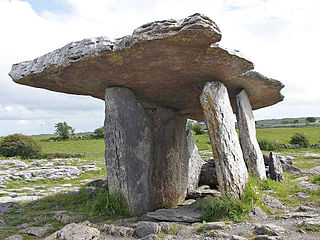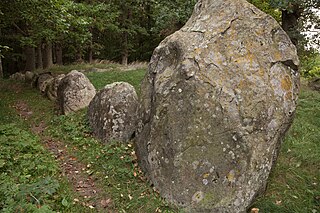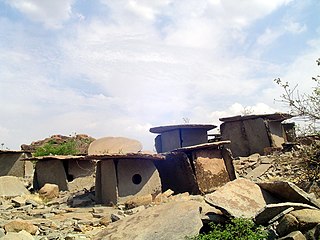
A dolmen is a type of single-chamber megalithic tomb, usually consisting of two or more vertical megaliths supporting a large flat horizontal capstone or "table". Most date from the early Neolithic and were sometimes covered with earth or smaller stones to form a tumulus. Small pad-stones may be wedged between the cap and supporting stones to achieve a level appearance. In many instances, the covering has weathered away, leaving only the stone "skeleton" of the mound intact.

A passage grave or passage tomb consists of one or more burial chambers covered in earth or with stone, and having a narrow access passage made of large stones. These structures usually date from the Neolithic Age, and are found largely in Western Europe. When covered in earth, a passage grave is a type of burial mound which are found in various forms all over the world. When a passage grave is covered in stone, it is a type of cairn.

A megalith is a large pre-historic stone that has been used to construct a structure or monument, either alone or together with other stones. There are over 35,000 in Europe alone, located widely from Sweden to the Mediterranean sea.

A tumulus is a mound of earth and stones raised over a grave or graves. Tumuli are also known as barrows, burial mounds or kurgans, and may be found throughout much of the world. A cairn, which is a mound of stones built for various purposes, may also originally have been a tumulus.

Hwasun County is a county in South Jeolla Province, South Korea.

A gallery grave is a form of megalithic tomb built primarily during the Neolithic Age in Europe in which the main gallery of the tomb is entered without first passing through an antechamber or hallway. There are at least four major types of gallery grave, and they may be covered with an earthen mound or rock mound.

Islandmagee is a peninsula and civil parish on the east coast of County Antrim, Northern Ireland, located between the towns of Larne and Whitehead. It is part of the Mid and East Antrim Borough Council area and is a sparsely populated rural community with a long history since the mesolithic period. In the early medieval period it was known as Semne, a petty-kingdom within Ulaid.

Poulnabrone dolmen is an unusually large dolmen or portal tomb located in the Burren, County Clare, Ireland. Situated on one of the most desolate and highest points of the region, it comprises three standing portal stones supporting a heavy horizontal capstone, and dates to the Neolithic period, probably between 4200 BC and 2900 BC. It the best known and most widely photographed of the approximately 172 dolmens in Ireland.

The Gochang, Hwasun and Ganghwa Dolmen Sites are the location of hundreds of stone dolmens which were used as grave markers, and for ritual purposes during the first millennium BCE when the Megalithic Culture was prominent on the Korean Peninsula. The sites were designated as a World Heritage Site by UNESCO in 2000. Korea is said to contain more than 40% of the world's dolmen, which are mostly concentrated in these three sites.
This article describes several characteristic architectural elements typical of European megalithic structures.

Concentrations of megaliths, dolmens and stone labyrinths dating between the end of the 4th millennium and the beginning of the 2nd millennium B.C. have been found throughout the Caucasus Mountains, including Abkhazia. Most of them are represented by rectangular structures made of stone slabs or cut in rocks with holes in their facade. These dolmens cover the Western Caucasus on both sides of the mountain ridge, in an area of approximately 12,000 square kilometres of Russia and Abkhazia.

The Meehambee Dolmen is a megalithic portal tomb dating from about 3500 BC located in County Roscommon, Ireland.

In the area of present-day Mecklenburg-Vorpommern, Germany, up to 5,000 megalith tombs were erected as burial sites by people of the Neolithic Funnelbeaker (TRB) culture. More than 1,000 of them are preserved today and protected by law. Though varying in style and age, megalith structures are common in Western Europe, with those in Mecklenburg-Vorpommern belonging to the youngest and easternmost—further east, in the modern West Pomeranian Voivodeship of Poland, monuments erected by the TRB people did not include lithic structures, while they do in the south (Brandenburg), west and north (Denmark).

The Great dolmen of Dwasieden, is a great dolmen in the borough of Sassnitz, on the Jasmund peninsula of Germany's largest island, Rügen. It was excavated in 1970 by Ewald Schuldt and is designated a Sprockhoff No. 472. The megalithic site of the Funnelbeaker culture (TBK) was constructed between 3500 and 2800 BC.

The great dolmen or grand dolmen is a type of megalithic site of the Funnelbeaker culture (TBK) that occurs in Nordic megalith architecture, primarily in the east of what is now German Mecklenburg-Vorpommern, and which has two different types of entrance. Neolithic monuments are features of the culture and ideology of Neolithic communities. Their evolution and function act as indicators of social development. The type of site, called Stordysse in Danish, does not follow the criteria listed below. In Germany, dolmens with three or more capstones are described as great dolmens and are divided into:

Nordic megalith architecture is an ancient architectural style found in Northern Europe, especially Scandinavia and North Germany, that involves large slabs of stone arranged to form a structure. It emerged in northern Europe, predominantly between 3500 and 2800 BC. It was primarily a product of the Funnelbeaker culture. Between 1964 and 1974, Ewald Schuldt in Mecklenburg-Western Pomerania excavated over 100 sites of different types: simple dolmens, extended dolmens, passage graves, great dolmens, unchambered long barrows, and stone cists. In addition, there are polygonal dolmens and types that emerged later, for example, the Grabkiste and Röse. This nomenclature, which specifically derives from the German, is not used in Scandinavia where these sites are categorised by other, more general, terms, as dolmens, passage graves and stone cists . Neolithic monuments are a feature of the culture and ideology of Neolithic communities. Their appearance and function serves as an indicator of their social development.

The simple dolmen or primeval dolmen is an early form of dolmen or megalithic tomb that occurs especially in Northern Europe. The term was defined by archaeologist, Ernst Sprockhoff, and utilised by Ewald Schuldt in publicising his excavation of 106 megalithic sites in the north German state of Mecklenburg-Vorpommern. The simple dolmen emerged in the early days of the development of megalithic monuments of the Funnelbeaker culture (TBK) and around 3,500 BC they appeared across almost the entire region covered by the stone cult structures of Nordic megalith architecture, but not in the Netherlands, in Lower Saxony west of the River Weser nor east of the River Oder and only once in Sweden.

A rectangular dolmen, extended dolmen or enlarged dolmen is a specific type of megalith, rectangular in shape, with upright sidestones and, usually, two capstones. The term rectangular dolmen was coined by Ekkehard Aner and is used especially in the German state of Schleswig-Holstein, where dolmens with this type of ground plan primarily occur. A more precise term, however, is extended dolmen, used by Ewald Schuldt and Ernst Sprockhoff, because these types of dolmen also occur with trapezoidal ground plans.

The unchambered long barrowearthen long barrow, non-megalithic long barrow or non-megalithic mound, is a type of long barrow found across the British Isles, in a belt of land in Brittany, and in northern Europe as far east as the River Vistula. The term "unchambered" means that there is no stone chamber within the stone enclosure. In Great Britain they are often known as non-megalithic long barrows or unchambered long cairns.

Hire Benakal is a megalithic site in the state of Karnataka, India. It is among a few Indian megalithic sites dated 800 BCE to 200 BCE which are located 10 kilometres (6.2 mi) west of Gangavati town in Koppal district and 35 kilometres (22 mi) from Hospet city. It contains roughly 400 megalithic funerary monuments, dated to the transition period between Neolithic and the Iron Age periods. Known locally in the Kannada language as elu guddagalu, their specific name is Moryar Gudda. Hire Benakal is reported to be the largest necropolis among the 2000 odd megalithic sites found in South India, mostly in Karnataka. Since 1955, it has been under the management of the Archaeological Survey of India (ASI) within the Dharwad circle. Hire Benakal has been proposed for recognition as an UNESCO World Heritage Site.






















